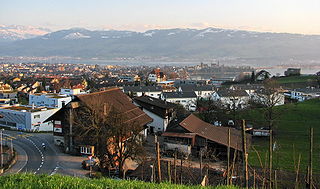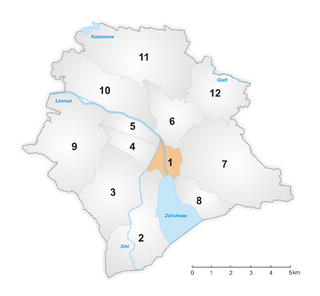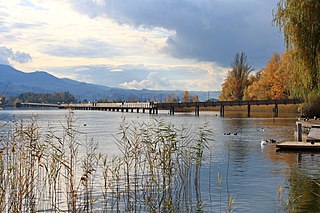
Lake Zurich is a lake in Switzerland, extending southeast of the city of Zürich. Depending on the context, Lake Zurich or Zürichsee can be used to describe the lake as a whole, or just that part of the lake downstream of the Seedamm at Rapperswil, whilst the part upstream of Rapperswil may be called the Obersee or Upper Lake.

Rapperswil-Jona is a municipality in the Wahlkreis (constituency) of See-Gaster in the canton of St. Gallen in Switzerland. Besides Rapperswil and Jona, which were separate municipalities until 2006, Rapperswil-Jona also includes Bollingen, Busskirch, Curtiberg, Kempraten-Lenggis, Wagen, and Wurmsbach.

Die Altstadt in the Swiss city of Zürich encompasses the area of the entire historical city before 1893, before the incorporation of what are now districts 2 to 12 into the municipality, over the period 1893 to 1934. Die Altstadt approximately corresponds to the area enclosed by the former city ramparts, and is today within the administrative area of the city called Kreis 1.

Ufenau is an island located, with the neighbouring island of Lützelau, in Lake Zürich in Switzerland between Freienbach and Rapperswil. Highlights on Ufenau include St. Peter & Paul church, St. Martin's chapel, and Ufenau's idyllic landscape in the Frauenwinkel protected area.

Rapperswil is a former municipality and since January 2007 part of the municipality of Rapperswil-Jona in the Wahlkreis (constituency) of See-Gaster in the canton of St. Gallen in Switzerland, located between Obersee and the main part of Lake Zurich.

Kempraten-Lenggis is a village (Kirchdorf) within the municipality of Rapperswil-Jona, Wahlkreis (constituency) of See-Gaster in the canton of St. Gallen in Switzerland. The remains of the Gallo-Roman settlement Centum Prata are one of the most important archaeological sites in the canton of St. Gallen; Centrum Prata is located at the so-called Kempratnerbucht, in Rapperswil and Busskirch on Zürichsee lake shore.

Rapperswil Castle is a castle, built in the early 13th century by the House of Rapperswil, in the formerly independent city of Rapperswil.

Holzbrücke Rapperswil-Hurden is a wooden pedestrian bridge between the city of Rapperswil and the village of Hurden crossing the upper Lake Zürich (Obersee) in Switzerland. The prehistoric timber piles discovered to the west of the Seedamm date back to 1523 BC. The island settlement Technikum is a prehistoric pile-dwelling settlement which is part of the UNESCO World Heritage Site Prehistoric Pile dwellings around the Alps. The first wooden footbridge led across Lake Zürich, followed by several reconstructions at least until the late 2nd century AD when the Roman Empire built a 6 metres (20 ft) wide wooden bridge. Between 1358 and 1360, Rudolf IV, Duke of Austria, built a 'new' wooden bridge across the lake that was used until 1878. On 6 April 2001, the reconstructed wooden footbridge was opened, being the longest wooden bridge in Switzerland.

Rathaus Rapperswil is the former Rathaus of the city government of medieval town of Rapperswil, Canton of St. Gallen in Switzerland. Today, the building houses a café and restaurant, the city archives and a collection of stained glass windows, silverware and paintings. The building and the city archives are listed in the Swiss inventory of cultural property of national and regional significance.

Hurden is a village in the municipality of Freienbach in the canton of Schwyz in Switzerland. First mentioned in 1217, the name "de Hurden" was used for the peninsula and for the fish traps made of woven work, called "Hürden" or "Hurden", which were used by the locals.

Stadtmuseum Rapperswil-Jona is a museum of local history and art in Rapperswil, canton of St. Gallen in Switzerland.

Stadtpfarrkirche St. Johann is a Roman Catholic parish church in the city of Rapperswil, canton of St. Gallen, Switzerland.

Turicum was a Gallo-Roman settlement at the lower end of Lake Zurich, and precursor of the city of Zürich. It was situated within the Roman province of Gallia Belgica and near the border to the province of Raetia; there was a tax-collecting point for goods traffic on the waterway Walensee–Obersee-Zürichsee–Limmat–Aare–Rhine.

The Obersee is the smaller of the two parts of Zürichsee in the cantons of St. Gallen and Schwyz in Switzerland.

Centum Prata is the name of a Roman vicus, whose remains are located on the eastern Zürichsee lakeshore in Kempraten, a locality of the municipality Rapperswil-Jona in the canton of St. Gallen in Switzerland. Centum Prata is the most important archaeological site from the Gallo-Roman era in the canton of St. Gallen.

Lindenhof in Rapperswil is a moraine hill and a public square being the historic center of Rapperswil, Switzerland.

Bürkliplatz is a town square in Zürich, Switzerland. It is named after Arnold Bürkli, and is one of nodal points of the road and public transportation, and of the lake shore promenades that were built between 1881 and 1887. The tree-shaded square between Bahnhofstrasse and Fraumünsterstrasse is called Stadthausanlage.

Lindenhof is the present name of the large fortified settlement, or oppidum, likely founded by the Helvetii on the Lindenhof hill on the western shore of the Limmat in Zürich, Switzerland.

Liebfrauenkapelle is a chapel in Rapperswil, Canton of St. Gallen, Switzerland, which dates back to the ossuary that was built by the House of Rapperswil around 1253 AD.

Einsiedlerhaus is a historic building with an adjoint garden which is part of the former town wall of the medieval Swiss town of Rapperswil in the Canton of St. Gallen.




























